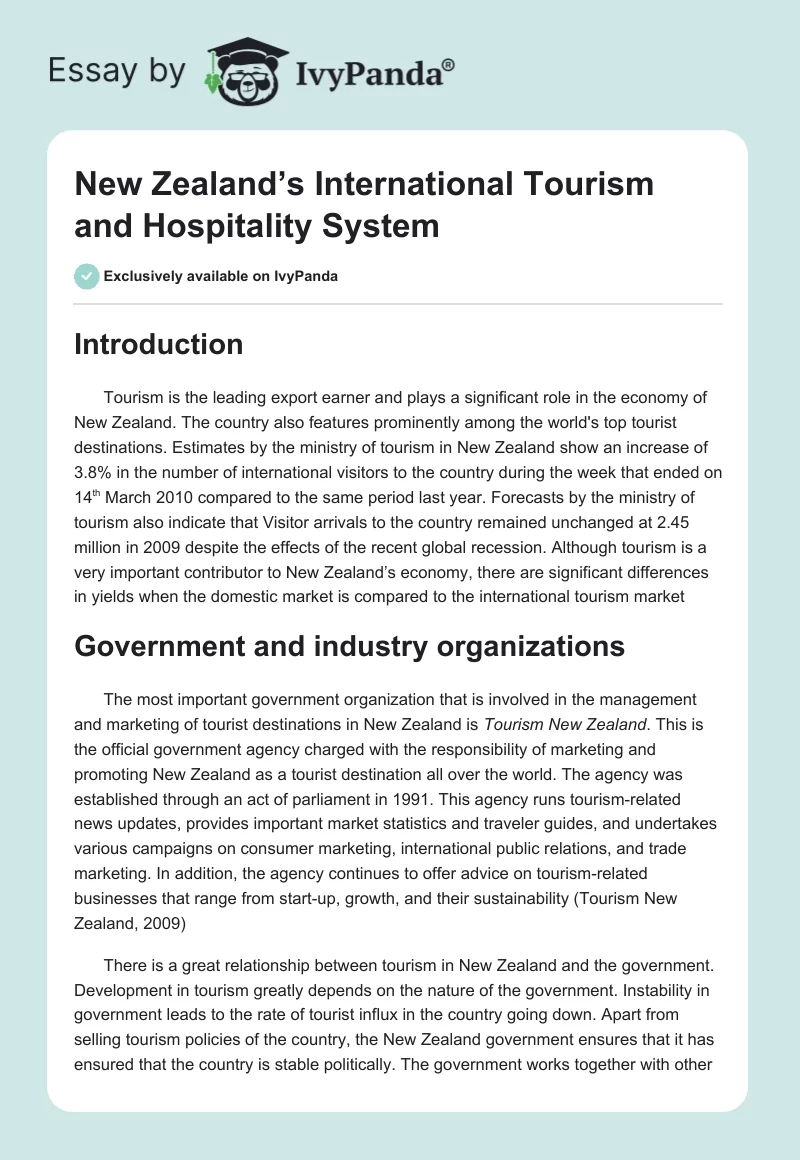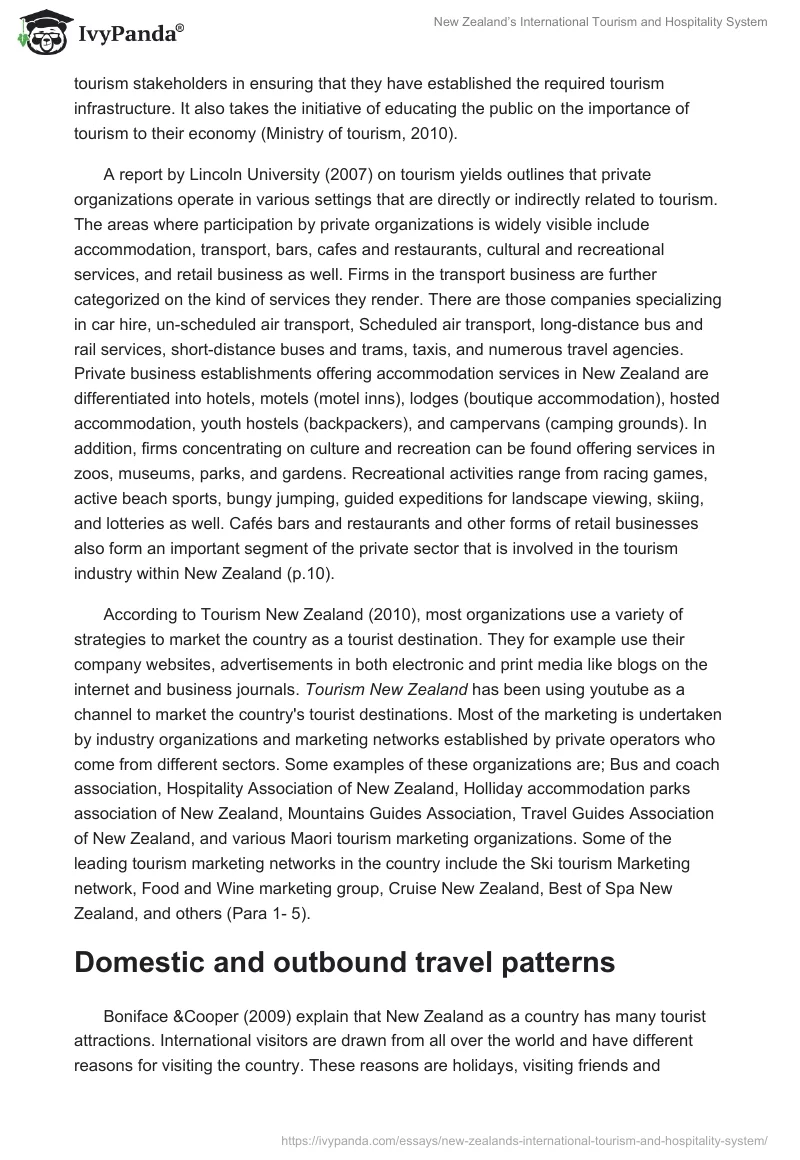Introduction
Tourism is the leading export earner and plays a significant role in the economy of New Zealand. The country also features prominently among the world’s top tourist destinations. Estimates by the ministry of tourism in New Zealand show an increase of 3.8% in the number of international visitors to the country during the week that ended on 14th March 2010 compared to the same period last year. Forecasts by the ministry of tourism also indicate that Visitor arrivals to the country remained unchanged at 2.45 million in 2009 despite the effects of the recent global recession. Although tourism is a very important contributor to New Zealand’s economy, there are significant differences in yields when the domestic market is compared to the international tourism market
Government and industry organizations
The most important government organization that is involved in the management and marketing of tourist destinations in New Zealand is Tourism New Zealand. This is the official government agency charged with the responsibility of marketing and promoting New Zealand as a tourist destination all over the world. The agency was established through an act of parliament in 1991. This agency runs tourism-related news updates, provides important market statistics and traveler guides, and undertakes various campaigns on consumer marketing, international public relations, and trade marketing. In addition, the agency continues to offer advice on tourism-related businesses that range from start-up, growth, and their sustainability (Tourism New Zealand, 2009)
There is a great relationship between tourism in New Zealand and the government. Development in tourism greatly depends on the nature of the government. Instability in government leads to the rate of tourist influx in the country going down. Apart from selling tourism policies of the country, the New Zealand government ensures that it has ensured that the country is stable politically. The government works together with other tourism stakeholders in ensuring that they have established the required tourism infrastructure. It also takes the initiative of educating the public on the importance of tourism to their economy (Ministry of tourism, 2010).
A report by Lincoln University (2007) on tourism yields outlines that private organizations operate in various settings that are directly or indirectly related to tourism. The areas where participation by private organizations is widely visible include accommodation, transport, bars, cafes and restaurants, cultural and recreational services, and retail business as well. Firms in the transport business are further categorized on the kind of services they render. There are those companies specializing in car hire, un-scheduled air transport, Scheduled air transport, long-distance bus and rail services, short-distance buses and trams, taxis, and numerous travel agencies. Private business establishments offering accommodation services in New Zealand are differentiated into hotels, motels (motel inns), lodges (boutique accommodation), hosted accommodation, youth hostels (backpackers), and campervans (camping grounds). In addition, firms concentrating on culture and recreation can be found offering services in zoos, museums, parks, and gardens. Recreational activities range from racing games, active beach sports, bungy jumping, guided expeditions for landscape viewing, skiing, and lotteries as well. Cafés bars and restaurants and other forms of retail businesses also form an important segment of the private sector that is involved in the tourism industry within New Zealand (p.10).
According to Tourism New Zealand (2010), most organizations use a variety of strategies to market the country as a tourist destination. They for example use their company websites, advertisements in both electronic and print media like blogs on the internet and business journals. Tourism New Zealand has been using youtube as a channel to market the country’s tourist destinations. Most of the marketing is undertaken by industry organizations and marketing networks established by private operators who come from different sectors. Some examples of these organizations are; Bus and coach association, Hospitality Association of New Zealand, Holliday accommodation parks association of New Zealand, Mountains Guides Association, Travel Guides Association of New Zealand, and various Maori tourism marketing organizations. Some of the leading tourism marketing networks in the country include the Ski tourism Marketing network, Food and Wine marketing group, Cruise New Zealand, Best of Spa New Zealand, and others (Para 1- 5).
Domestic and outbound travel patterns
Boniface &Cooper (2009) explain that New Zealand as a country has many tourist attractions. International visitors are drawn from all over the world and have different reasons for visiting the country. These reasons are holidays, visiting friends and relatives, for business, attending conferences, stopovers while traveling to other destinations, education and medical services with a minimal percentage with no specified reason for visiting the country. The major tourist centers for holidaymakers include Auckland, Rotorua found which are in the North Island, and Wellington. Popular attractions in these areas include sightseeing and adventure tourism (p. 527).
Thomas (2004) explains that Business tourism especially to the rural areas of New Zealand is mainly motivated by business interests in the agricultural and rural environment.with Rotorua being an important center for this form of tourism. One thing that is easily notable is that business tourism in rural areas mainly involves small tourist firms whose main aim is to provide the tourists with a unique experience of the rural life in New Zealand. The central marketing theme for this companies is presenting the country as “pure “ and natural beauty of the lands is what tourists come to see(p.141).
Rogers (2003) observes that conference tourism is another subsector in tourism that is growing very fast in New Zealand. This can be attributed to the increasing numbers of meetings and conferences that are being held in New Zealand. A reliable transport infrastructure combined with business and leisure has made New Zealand a preferred destination for international conferences especially in the capital city (Wellington) which is the most populous urban city.Stable and less frequent fluctuation of the country’s currency has also contributed to this trend as costs for organizing international conferences and annual meetings by public and international companies remain relatively stable. An estimated forty five thousand visitors attended various conferences in New Zealand in the year 2002 with corresponding revenue of two hundred and sixty million New Zealand dollars. The trend has continued on a positive note since then (p. 87).
According to Cooper&Hall (2005), New Zealand records most of its international visitors to come mostly from Australia while the United States, china, the United Kingdom, Japan, Canada, South Korea, Germany and Europe form the other important segment of long haul tourism markets for the country. New Zealanders are also known to be frequent travelers within their own country. They often travel to other parts of the country and spend nights out, in doing this they also spend money and this contributes to the national economy. The hot springs and geyser of Rotorua and the beaches on the Northern Island are favorite destinations for the locals. Reasons for domestic travel are also similar to those for international arrivals (p.109-115).
The number of New Zealanders travelling outside the country continues to increase significantly. Majority travel for leisure and business with small percentages travelling for education and medical services.According to a study conducted in 2005, it was found that domestic visitor nights had gone down from 66.7m in 1999 to 51.8m in 2005. This was attributed to decrease in number of holidays in the country. Local overnight expenses were found to be dynamic with their revenue increasing from 3.81b in 1999 to $4.94b before then depreciating to $4.17b in 2005. On the other hand, outbound trips were found to increase significantly. This was as a result of strong exchange rate and decrement in international transportation cost. The total number outbound and domestic nights were found to remain stable at 90m from 1999 to 2005.Outbound trips were reported to increase by 26% and 34% in 2004 and 2005 respectively. This was reported in all areas of travel with holiday travel registering the highest rate (Ministry of tourism, 2010).
Conclusion
In discussing sustainability and marketing of tourism in different countries ,Edgell (2006) notes that New Zealand has been able to successful market itself as top tourist destination and this has positively impacted on the sustainability of the tourism industry. The other countries that have also been able to achieve this are Australia, Canada, Costa Rica and most of the European(p.36).Tourism in New Zealand contributes significantly to the country’s economy and provides employment to many New Zealanders through various occupations that open up in different sectors of the tourism industry.
Reference
Boniface, B and Cooper, Chris. (2009).Worldwide Destinations: The Geography of Travel andTourism. Burlington, Butterworth-Heinnman.
Cooper, Chris and Hall, Michael C. (2005). Oceania: a tourism handbook. Bristol, Channel view publications.
Edgell, D. (2006).Managing sustainable tourism: a legacy for the future. New York, Routledge.
Lincoln university. (2007).EnhancingFinancial and Economic yield in tourism: A summary report of the yield research programme. New Zealand. Web.
Ministry of tourism. (2010).New Zealand Domestic and Outbound Travel Patterns report, 2005. New Zealand. Web.
Rogers, T. (2003).Conferences and conventions: a global industry. Burlington, Butterworth-Heinnman.
Thomas, R. (2004). Small firms in tourism: international perspectives. Amsterdam, Elsevier.
Tourism New Zealand (2010).Official website. New Zealand. Web.


